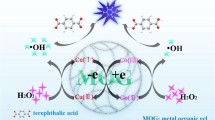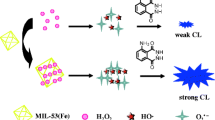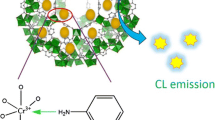Abstract
A metal-organic gel (MOG) was synthesized that is composed of manganese(II) as the central ion and 1,10-phenanthroline-2,9-dicarboxylic acid as the ligand. The resulting MOG exhibits excellent activity for catalyzing the chemiluminescence (CL) of the luminol/hydrogen peroxide system. The CL system was characterized by CL spectra, UV-vis absorption spectra and by studying potential interferences by common radical scavengers. The CL reaction was exploited in a new scheme for the determination of hydrogen peroxide. CL intensity increases linearly in the 0.4 μM ~ 3 mM hydrogen peroxide concentration range, and the limit of detection (LOD) is 0.12 μM. The method was extended to an enzymatic assay for glucose by using glucose oxidase and by measurement of the enzymatically formed hydrogen peroxide. The assay works in the 0.2 μM ~ 3 mM glucose concentration range, and the LOD is 0.08 μM.

Schematic representation of the synthesized Mn-containing MOGs catalyzing luminol-hydrogen peroxide chemiluminescent reaction, which can be used to establish a new CL method for the detection of hydrogen peroxide and glucose.




Similar content being viewed by others
References
He L, Peng ZW, Jiang ZW, Tang XQ, Huang CZ, Li YF (2017) Novel iron(iii)-based metal-organic gels with superior catalytic performance towards luminol chemiluminescence. ACS Appl Mater Interfaces 9(37):31834–31840
Pang X, Yu X, Lan H, Ge X, Li Y, Zhen X, Yi T (2015) Visual recognition of aliphatic and aromatic amines using a fluorescent gel: application of a sonication-triggered organogel. ACS Appl Mater Interfaces 7(24):13569–13577
Martínez-Calvo M, Kotova O, MoBius ME, Bell AP, McCabe T, Boland JJ, Gunnlaugsson T (2015) Healable luminescent self-assembly supramolecular metallogels possessing lanthanide (eu/tb) dependent rheological and morphological properties. J Am Chem Soc 137(5):1983–1992
Zhang J, Su CY (2013) Metal-organic gels: from discrete metallogelators to coordination polymers. Coord Chem Rev 257(7–8):1373–1408
Tan SY, Ang CY, Mahmood A, Qu Q, Li P, Zou R, Zhao Y (2016) Doxorubicin-loaded metal-organic gels for ph and glutathione dual-responsive release. Chemnanomat 2(6):504–508
Sui J, Wang L, Zhao W, Hao J (2016) Iron-naphthalenedicarboxylic acid gels and their high efficiency in removing arsenic(v). Chem Commun 52(43):6993–6996
Wei SC, Pan M, Li K, Wang S, Zhang J, Su CY (2014) A multistimuli-responsive photochromic metal-organic gel. Adv Mater 26(13):2072–2077
Karan CK, Sau MC, Bhattacharjee M (2017) A copper(ii) metal-organic hydrogel as a multifunctional precatalyst for cuaac reactions and chemical fixation of co2 under solvent free conditions. Chem Commun 53(9):1526–1529
Li YX, Zhao DH, Zhu CQ, Wang L, Xu JG (2002) Determination of proteins at nanogram levels by their quenching effect on the chemiluminscence reaction between luminol and hydrogen peroxide with manganese-tetrasulfonatophthalocyanine as a new catalyst. Anal Bioanal Chem 374(3):395–398. https://doi.org/10.1007/s00216-002-1498-1
Li YX, Zhu CQ, Wang L, Gao F, Li MG, Wang LY, Zhu YW (2001) Application of manganese-tetrasulfonatophthalo-cyanine as a new mimetic peroxidase in the determination of hydrogen peroxide by chemiluminescence reaction with luminol. Anal Lett 34(11):1841–1850. https://doi.org/10.1081/al-100106115
Chen H, Gao Q, Li J, Lin JM (2016) Graphene materials-based chemiluminescence for sensing. J Photoch Photobio C 27:54–71
Li Y, Yang P, Wang P, Wang L (2007) Development of a novel luminol chemiluminescent method catalyzed by gold nanoparticles for determination of estrogens. Anal Bioanal Chem 387(2):585–592. https://doi.org/10.1007/s00216-006-0925-0
Guan G, Yang L, Mei Q, Zhang K, Zhang Z, Han MY (2012) Chemiluminescence switching on peroxidase-like fe3o4 nanoparticles for selective detection and simultaneous determination of various pesticides. Anal Chem 84(21):9492–9497
Iranifam M, Imani-Nabiyyi A, Khataee A, Kalantari J (2016) Enhanced luminol-o2 chemiluminescence reaction by cuo nanoparticles as oxidase mimics and its application for determination of ceftazidime. Anal Methods 8(18):3816–3823
Ma H, Li X, Yan T, Li Y, Liu H, Zhang Y, Wu D, Du B, Wei Q (2016) Sensitive insulin detection based on electrogenerated chemiluminescence resonance energy transfer between ru(bpy)(3)(2+) and au nanoparticle-doped beta-cyclodextrin-pb (ii) metal-organic framework. ACS Appl Mater Interfaces 8(16):10121–10127. https://doi.org/10.1021/acsami.5b11991
Yang N, Song H, Wan X, Fan X, Su Y, Lv Y (2015) A metal (co)-organic framework-based chemiluminescence system for selective detection of l-cysteine. Analyst 140(8):2656–2663. https://doi.org/10.1039/c5an00022j
Zhu Q, Chen Y, Wang W, Zhang H, Ren C, Chen H, Chen X (2015) A sensitive biosensor for dopamine determination based on the unique catalytic chemiluminescence of metal-organic framework hkust-1. Sensors Actuators B Chem 210:500–507. https://doi.org/10.1016/j.snb.2015.01.012
Zhu Q, Dong D, Zheng X, Song H, Zhao X, Chen H, Chen X (2016) Chemiluminescence determination of ascorbic acid using graphene oxide@copper-based metal-organic frameworks as a catalyst. RSC Adv 6(30):25047–25055. https://doi.org/10.1039/c5ra27636e
Yi X, Dong W, Zhang X, Xie J, Huang Y (2016) Mil-53(fe) mof-mediated catalytic chemiluminescence for sensitive detection of glucose. Anal Bioanal Chem 408(30):8805–8812
Tang Y, Su Y, Yang N, Zhang L, Lv Y (2014) Carbon nitride quantum dots: a novel chemiluminescence system for selective detection of free chlorine in water. Anal Chem 86(9):4528
Laskin A, Cowin JP (2001) Automated single-particle sem/edx analysis of submicrometer particles down to 0.1 μm. Anal Chem 73(5):1023–1029. https://doi.org/10.1021/ac0009604
Fujiwara M, Matsushita T, Ikeda S (1995) Evaluation of mn3s x-ray photoelectron spectroscopy for characterization of manganese complexes. J Electron Spectrosc Relat Phenom 74(3):201–206. https://doi.org/10.1016/0368-2048(94)02375-1
Ai LH, Li LL, Zhang CH, Fu J, Jiang J (2013) Mil-53(fe): a metal-organic framework with intrinsic peroxidase-like catalytic activity for colorimetric biosensing. Chem Eur J 19(45):15105–15108. https://doi.org/10.1002/chem.201303051
Wang WF, Schuchmann MN, Schuchmann HP, Knolle W, von Sonntag J, von Sonntag C (1999) Radical cations in the oh-radical-induced oxidation of thiourea acid tetramethylthiourea in aqueous solution. J Am Chem Soc 121(1):238–245. https://doi.org/10.1021/ja983275b
Schaap AP, Thayer AL, Faler GR, Goda K, Kimura T (1974) Singlet molecular oxygen and superoxide dismutase. J Am Chem Soc 96(12):4025–4026. https://doi.org/10.1021/ja00819a055
Harbour JR, Issler SL (1982) Involvement of the azide radical in the quenching of singlet oxygen by azide anion in water. J Am Chem Soc 104(3):903–905. https://doi.org/10.1021/ja00367a066
Lin T, Son Z, Wu Y, Ling C, Wang S, Fu F, Guo L (2018) Boron- and phenyl-codoped graphitic carbon nitride with greatly enhanced light responsive range for photocatalytic disinfection. J Hazard Mater 358(15):62–68
Song Z, Kwok RT, Ding D, Nie H, Lam JW, Liu B, Tang BZ (2016) An AIE-active fluorescence turn-on bioprobe mediated by hydrogen-bonding interaction for highly sensitive detection of hydrogen peroxide and glucose. Chem Commun 52(65):10076–10079
Tang W, Li L, Zeng X (2015) A glucose biosensor based on the synergistic action of nanometer-sized TiO 2 and polyaniline. Talanta 131:417–423
Nakashima K, Wada M, Kuroda N, Akiyama S, Imai K (1994) High-performance liquid chromatographic determination of hydrogen peroxide with peroxyoxalate chemiluminescence detection. J Liq Chromatogr 17(10):2111–2126
Kondo T, Tamura A, Kawai T (2009) Cobalt phthalocyanine-modified boron-doped diamond electrode for highly sensitive detection of hydrogen peroxide. J Electrochem Soc 156(11):F145–F150
Hong J, Maguhn J, Freitag D, Kettrup A (1998) Determination of H2O2 and organic peroxides by high-performance liquid chromatography with post-column UV irradiation, derivatization and fluorescence detection. Fresenius J Anal Chem 361(2):124–128
Wang WK, Xia H (2004) Electrochemical depletion of ascorbic acid in the detection of hydrogen peroxide——an investigation using SECM. Acta Chim Sin 62(14):1339–1343
Navas DA, Ramos PMC, Torijas MMC (1998) Sol–gel horseradish peroxidase biosensor for hydrogen peroxide detection by chemiluminescence. Anal Chim Acta 363(2–3):221–227
Zhang B, Zhang X, Huang D, Li S, Yuan H, Wang M, Shen Y (2015) Co 9 S 8 hollow spheres for enhanced electrochemical detection of hydrogen peroxide. Talanta 141:73–79
Acknowledgments
This work is financially supported by the National Natural Science Foundation of China (No.21775003, No.21375002), and the Foundation for Innovation Team of Bioanalytical Chemistry of Anhui Province.
Author information
Authors and Affiliations
Corresponding author
Ethics declarations
Conflict of interest
The author(s) declare that they have no competing interests.
Additional information
Publisher’s note
Springer Nature remains neutral with regard to jurisdictional claims in published maps and institutional affiliations.
Electronic supplementary material
ESM 1
(DOCX 50 kb)
Rights and permissions
About this article
Cite this article
Yu, J., Cao, M., Wang, H. et al. Novel manganese(II)-based metal-organic gels: synthesis, characterization and application to chemiluminescent sensing of hydrogen peroxide and glucose. Microchim Acta 186, 696 (2019). https://doi.org/10.1007/s00604-019-3808-8
Received:
Accepted:
Published:
DOI: https://doi.org/10.1007/s00604-019-3808-8




